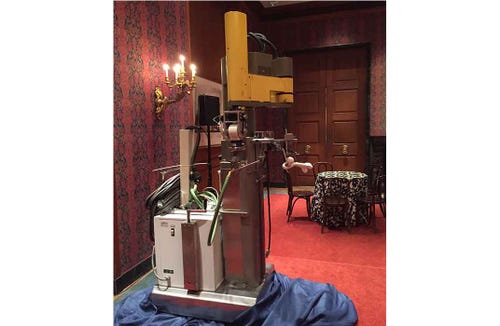How a Medical Device Prototype Ended Up in the Smithsonian
December 1, 2016
The National Museum of American History added the first robotic medical device into its collection this month with the induction of the Robodoc, the world's first active robotic surgical system.
Kristopher Sturgis

The Smithsonian's National Museum of American History announced this month the acquisition of the Robodoc, a 1989 prototype that went on to become a groundbreaking orthopedic surgical device for hip and knee replacement surgeries. The device, created by THINK Surgical Inc in Fremont, California, became the world's first surgical robotic system to perform active procedures in the operating room following a surgeon's commands.
The prototype was the brainchild of two researchers from the University of California, Davis, who collaborated on a cutting-edge system designed for total hip arthroplasty in 1986--an effort that was aimed at creating a device that could provide joint-replacements tailored for individual patients. At the time, joint replacements were far from precise and total hip arthroplasties were performed by hand, saddling patients with loose fitting implants that caused harmful complications such a bone splintering.
UC Davis researchers Howard A. Paul and William Bargar decided to look toward computer-assisted design and computer-assisted manufacturing technologies to design implants from the patient's CT scan data. Armed with new custom implants that could fit the individual patient's body like a glove, the two then decided to seek the help of IBM's Thomas J. Watson Research Lab where they could work with a group to develop an automated machine language that could help guide a robotic surgical system that could implant the custom joint replacements.
Using IBM's developed language, the group now had a robotic surgical system that could actually carry out specific directions to complete a joint-replacement procedure using custom designed implant materials. By 1992, Paul and Bargar had convinced FDA to allow them to do a feasibility study on human subjects, and the results were quite groundbreaking. Their initial studies proved that the robotic system aided in joint replacement surgeries with unprecedented precision and success.
Despite a few setbacks, and a brief sabbatical when the company ran low on funds, the device was eventually backed by a Korean company called Curexo, who eventually became the parent company of THINK Surgical. The new company soon found the funds to complete the necessary study for FDA approval, officially making the Robodoc the first approved robotic surgical system. To this day the technology remains the only active robotic surgical system that can complete a procedure entirely on its own following the commands of a surgeon.
Despite its success, the Robodoc certainly isn't the only robotic surgical tool making a splash in the medtech market. Earlier this week Cambridge Consultants announced the arrival of Axsis, a new miniature robotic tool designed for delicate, minimally invasive surgical procedures. The tool is one of the few flexible robotic technologies aimed at increasing both precision and functionality for procedures in the operating room. The announcement signals that the operating room may no longer be a space monopolized by just the Robodoc.
As for the Robodoc's induction into the Smithsonian, the museum announced it will be included in their division of medicine and science beginning in November of 2016. Considering the device's history, it seems appropriate that the first robotic system used in the modern operating room become the first robotic medical device preserved in the National Museum of American History.
Kristopher Sturgis is a contributor to Qmed.
Like what you're reading? Subscribe to our daily e-newsletter.
[image courtesy of THE NATIONAL MUSEUM OF AMERICAN HISTORY/SMITHSONIAN MAGAZINE]
About the Author(s)
You May Also Like
.png?width=300&auto=webp&quality=80&disable=upscale)

